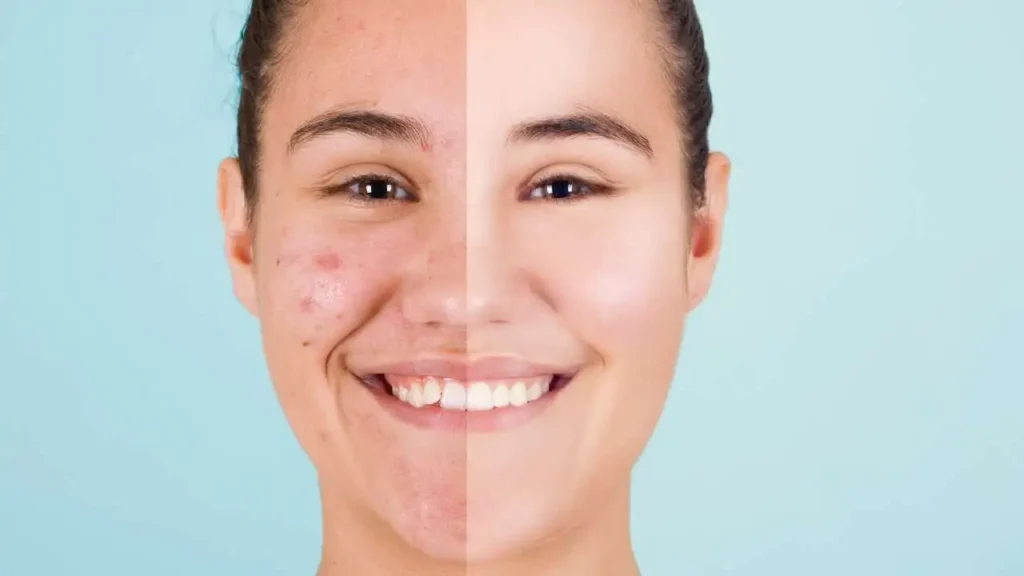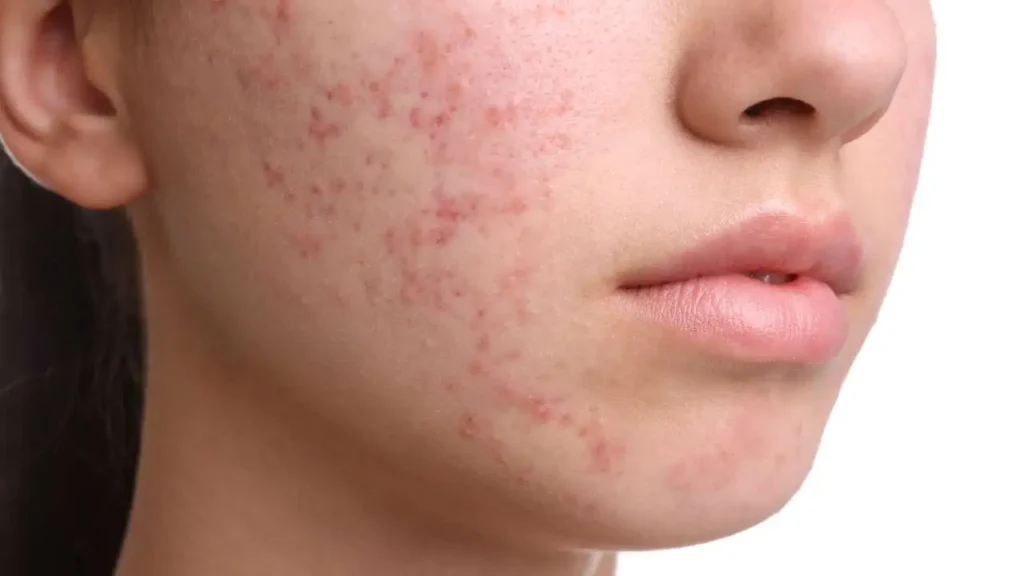Have you ever struggled with persistent acne that just won’t go away no matter what skincare routine you try? What if I told you it might not be traditional acne at all? Fungal acne, often mistaken for bacterial acne, is a sneaky skin condition that’s commonly misdiagnosed. Understanding the difference between the two is crucial because fungal acne requires a very different treatment approach.
In this comprehensive guide, we’ll dive deep into the world of fungal acne, uncover its causes, identify key symptoms, and, most importantly, show you how to effectively treat and prevent it. By the end of this article, you’ll have the knowledge you need to tackle fungal acne head-on and restore your skin’s natural balance.
What is Fungal Acne?
Fungal acne, despite its name, isn’t truly acne in the traditional sense. Scientifically known as Malassezia folliculitis or Pityrosporum folliculitis, it occurs when there’s an overgrowth of yeast (specifically Malassezia) on the skin. This yeast is a type of fungus that lives naturally on our skin, but under certain conditions, it multiplies excessively and invades the hair follicles, causing tiny, acne-like bumps to form.
Fungal acne most commonly appears on the chest, back, shoulders, and occasionally the face. It can be itchy, persistent, and frustrating to deal with, especially if it’s being treated like bacterial acne, which may worsen the condition.
The Difference Between Fungal Acne and Bacterial Acne
At first glance, fungal acne and traditional bacterial acne look quite similar, making it hard to tell them apart. However, understanding the key differences is essential for choosing the right treatment.
Bacterial Acne
- Caused by P. acnes bacteria clogging pores.
- Appears as whiteheads, blackheads, cysts, and nodules.
- Common on the face, chest, shoulders, and back.
- Often influenced by hormonal changes and oily skin.
- Can be treated with salicylic acid, benzoyl peroxide, and antibiotics.
Fungal Acne
- Caused by an overgrowth of Malassezia yeast in hair follicles.
- Appears as uniform, small red bumps (pustules) often grouped together.
- Often appears on the chest, back, and sometimes the face.
- Triggered by hot, humid environments, excessive sweating, or use of oily skincare products.
- Requires antifungal treatments such as ketoconazole or other antifungal agents.
Also read: The Chemical Peel Recovery Process: A Complete Guide for Optimal Results
What Causes Fungal Acne?
Fungal acne occurs when the balance of yeast on your skin is disrupted, leading to overgrowth. Here are some of the most common causes and risk factors:
Heat and Humidity
Hot and humid conditions create a moist environment on your skin that yeast loves. Sweating, combined with tight, non-breathable clothing, traps moisture and creates a breeding ground for Malassezia.
Excessive Sweating
Sweating during workouts, hot weather, or even due to hormonal fluctuations can increase the risk of fungal acne. Not showering immediately after sweating further exacerbates the condition.
Use of Oily Skincare Products
Certain oils and greasy skincare products can clog pores and feed the yeast, promoting its growth. Products containing fatty acids, esters, or certain oils (like coconut oil) are especially problematic for those prone to fungal acne.
Overuse of Antibiotics
Long-term use of oral or topical antibiotics can reduce the levels of bacteria on your skin, allowing yeast to grow unchecked.
Weakened Immune System
Those with a compromised immune system, such as individuals with autoimmune disorders or those taking immunosuppressive medications, are more susceptible to fungal infections.
Tight, Non-Breathable Clothing
Wearing tight, synthetic fabrics that don’t allow air to circulate can trap moisture and heat against the skin, fostering yeast overgrowth.
Symptoms and How to Recognize Fungal Acne
Recognizing fungal acne is the first step in treating it effectively. Because it mimics traditional acne, you might be dealing with it without realizing it. Here are the hallmark signs:
- Small, uniform, itchy red bumps that are usually grouped together.
- Bumps often appear on the chest, back, shoulders, and sometimes the face.
- Acne treatments like benzoyl peroxide or salicylic acid may not work, and sometimes make it worse.
- Itchiness is a key sign, as traditional acne usually doesn’t itch.
- No presence of blackheads or deep cystic acne, which are common in bacterial acne.
Fungal acne is stubborn but treatable once identified. If you’re experiencing these symptoms, you may want to consider antifungal treatments instead of typical acne medications.
Diagnosis: Is it Fungal Acne?
Because fungal acne looks so similar to bacterial acne, diagnosis can be tricky. Here’s how you can determine if you’re dealing with fungal acne:
Visit a Dermatologist
A dermatologist may take a skin scraping and examine it under a microscope to confirm the presence of yeast. This is the most accurate way to diagnose fungal acne.
Try an Antifungal Treatment
If you suspect fungal acne but can’t see a dermatologist right away, you can try an over-the-counter antifungal treatment, such as ketoconazole shampoo. Apply it to the affected areas and leave it on for about 5-10 minutes before rinsing. If your condition improves, fungal acne is likely the culprit.
Avoid Acne Medications
If you’ve been treating your skin with typical acne medications (salicylic acid, benzoyl peroxide) without success, fungal acne could be to blame. These medications are ineffective against yeast and may aggravate the condition.

The Best Treatments for Fungal Acne
Treating fungal acne requires a shift in your skincare routine. Instead of using typical acne treatments, you’ll need to focus on antifungal agents. Here’s a guide to the most effective treatments:
Over-the-Counter Treatments
- Ketoconazole Shampoo (1% or 2%): This dandruff shampoo doubles as a topical antifungal treatment. Apply it to the affected areas on your body, leave it on for 5-10 minutes, then rinse it off. Use this method 2-3 times a week.
- Selenium Sulfide Shampoo: Another dandruff shampoo, this one contains selenium sulfide, which has antifungal properties. Use it in a similar manner to ketoconazole.
- Clotrimazole Cream: An antifungal cream available over the counter. Apply it to the affected areas 1-2 times a day.
Prescription Treatments
- Oral Antifungals: If your fungal acne is widespread or severe, a dermatologist may prescribe an oral antifungal medication such as itraconazole or fluconazole. These work internally to reduce yeast overgrowth.
- Prescription Strength Ketoconazole: Your dermatologist may prescribe a stronger version of ketoconazole cream or shampoo if over-the-counter products aren’t effective.
Natural Remedies
Some individuals prefer natural treatments for fungal acne. While they may not be as fast-acting as antifungal medications, certain natural remedies have shown promise:
- Tea Tree Oil: Known for its antifungal properties, tea tree oil can help reduce yeast growth. Be sure to dilute it with a carrier oil (like jojoba) before applying it to your skin.
- Apple Cider Vinegar: Diluted apple cider vinegar can be applied as a toner to balance the skin’s pH and create an environment less conducive to yeast overgrowth.
Fungal Acne Skincare Routine: Do’s and Don’ts
Crafting a skincare routine for fungal acne requires special consideration. Here’s how to build an effective regimen that keeps fungal acne at bay:
Cleansing
- Use a gentle, non-oily cleanser twice daily.
- Once or twice a week, use ketoconazole shampoo as a body and face wash.
- Avoid cleansers with oils or fatty acids, as these can feed yeast.
Moisturizing
- Opt for light, oil-free moisturizers or gel-based moisturizers.
- Avoid products that contain fatty acids or oils that can promote yeast growth (e.g., coconut oil, olive oil).
Exfoliating
- Regular exfoliation helps remove dead skin cells and prevent clogged pores.
- Use gentle chemical exfoliants like salicylic acid (in moderation) to avoid irritating the skin.
Prevention: How to Keep Fungal Acne at Bay
Once you’ve treated fungal acne, prevention is key to keeping it from coming back. Here are some tips to help you avoid future flare-ups:
- Shower immediately after sweating to remove excess yeast and sweat from your skin.
- Wear loose, breathable fabrics like cotton or moisture-wicking materials.
- Avoid oily skincare products that can feed yeast.
- Keep your skin dry, especially in areas prone to sweating.
- Use antifungal body wash (like ketoconazole shampoo) weekly to maintain skin balance.
Lifestyle Tips for Clearer Skin
Addressing fungal acne involves more than just topical treatments. Here are some lifestyle changes that can help keep your skin clear and healthy:
Maintain Good Hygiene
- Shower regularly, especially after workouts or sweating.
- Change out of sweaty clothes as soon as possible.
Manage Stress
Stress can weaken your immune system, making you more susceptible to infections. Practice stress-reducing activities such as yoga, meditation, or regular exercise.
Avoid Excessive Heat and Humidity
If possible, limit time spent in environments that promote sweating, such as saunas or steam rooms. If you live in a hot climate, use a fan or air conditioning to keep your skin cool.
Frequently Asked Questions about Fungal Acne
With proper treatment, you should start seeing improvement in 1-2 weeks. However, it may take several weeks for the acne to completely clear up. Consistency is key!
Yes, fungal acne can spread, especially if you sweat or use infected towels or clothing. Be sure to practice good hygiene and treat the affected areas promptly.
While diet isn’t a direct cause of fungal acne, a high-sugar diet can feed yeast growth. Reducing sugar and carbohydrate intake may help improve your skin’s condition.
Fungal acne is not contagious in the way bacterial infections are. However, yeast can spread through shared items like towels, so it’s best to avoid sharing personal items.
Conclusion
Fungal acne is a common but often misdiagnosed skin condition. While it may look like traditional acne, it requires specific antifungal treatments to clear it up effectively. Understanding its causes, symptoms, and treatment options will help you manage this condition and achieve clearer, healthier skin.
If you’re unsure whether you’re dealing with fungal acne, consult a dermatologist for proper diagnosis. With the right treatment and skincare routine, you can banish fungal acne and prevent it from returning. Remember, consistency in treatment is key to long-term results!


